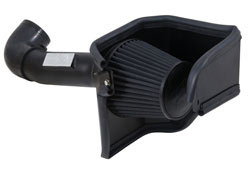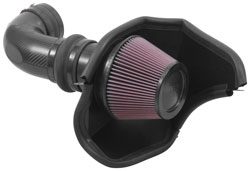K&N Air Intakes Add as Much as 39 Estimated HP to Your Third Generation Hemi Engine
- 28 ago 2017
By far the most prevalent version of the Hemi engine is the third generation, that’s been available in four different displacements: 5.7 L, 6.1 L, 6.2 L, and 6.4 L. Fortunately, for owners of Chrysler and Dodge cars and trucks powered by the third generation Hemi, K&N offers a wide range of air intake kits that increase engine power and response. 5.7L Hemi Applications and Estimated Horsepower The first of the generation three Hemi appeared in the Dodge Ram 1500, 2500, and 3500 in the 2003 model year. While not exactly a hemispherical combustion chamber as in past Hemi designs, this new combustion chamber is based on Hemi principles, updated with knowledge gained about airflow over the last 35 years along with advice from Tom Hoover, the designer of the second generation 426 Hemi. The engine displaces 5.7L or 348 CID, and at its introduction produced one horsepower per cubic inch. Upgrades to the 5.7L motor raised output to 390 horsepower. Dodge Ram 5.7L 2003-2008 Ram 1500, 2500, 3500 77-1533KP +8.34 est. HP 2003-2008 Ram 1500, 2500, 3500 71-1533 Blackhawk air intake +9.62 est. HP 2003-2008 Ram 1500, 2500, 2500 57-1533 FIPK air intake +10.48 est. HP 2009-2017 Ram 1500, 2500, 3500 77-1561KP +10.3 est. HP
2009-2017 Ram 1500, 2500, 3500 71-1561 Blackhawk air intake +7.17 est. HP 2009-2017 Ram 1500, 2500, 3500 57-1561 FIPK air intake +15.66 est. HP Dodge Durango 5.7L 2004-2009 Durango 77-1539KP +15.57 est. HP 2004-2009 Durango 57-1539 FIPK air intake +17.54 est. HP 2011-2017 Durango 77-1563KP +15.01 est. HP 2011-2017 Durango 57-1563 FIPK air intake +17.00 est. HP Dodge Charger 2006-2017 Charger 71-1542 Blackhawk air intake +14.13 est. HP 2006-2017 Charger 57-1542 FIPK air intake +21.09 est. HP 2006-2017 Charger 69-2526TP Typhoon air intake +11.66 est. HP (w/o shaker hood) Dodge Challenger 2008-2017 Challenger 71-1542 Blackhawk air intake +14.13 est. HP 2008-2017 Challenger 57-1542 FIPK air intake +21.09 est. HP 2008-2017 Challenger 69-2526TP Typhoon air intake +11.66 est. HP (w/o shaker hood) Chrysler 300, 300C 2005-2017 300, 300C 71-1542 Blackhawk air intake +14.13 est. HP 2005-2017 300, 300C 57-1542 FIPK air intake +21.09 est. HP 2005-2017 300, 300C 69-2526TP Typhoon air intake +11.66 est. HP Dodge Magnum 2005-2008 Magnum 71-1542 Blackhawk air intake +14.13 est. HP 2005-2008 Magnum 57-1542 FIPK air intake +21.09 est. HP 2005-2008 Magnum 69-2526TP Typhoon air intake +11.66 est. HP 6.1 L Hemi Applications and Estimated Horsepower Chrysler upgraded the 5.7L to create a high-performance 6.1L version of the third generation Hemi. A revised block with an increased bore, forged crankshaft, lighter pistons, and heavy-duty connecting rods were all part of the modifications. All were installed in the SRT-8 series of vehicles. Chrysler 300C SRT-8 2005-2010 300C SRT8 71-1542 Blackhawk air intake +14.13 est. HP 2005-2010 300C SRT8 57-1542 FIPK air intake +21.09 est. HP 2005-2010 300C SRT8 69-2526TP Typhoon air intake +11.66 est. HP
Dodge Magnum SRT-8 2005-2008 Magnum 71-1542 Blackhawk air intake +14.13 est. HP 2005-2008 Magnum 57-1542 FIPK air intake +21.09 est. HP 2005-2008 Magnum 69-2526TP Typhoon air intake, +11.66 est. HP
Dodge Charger SRT-8 2005-2010 Charger SRT-8 71-1542 Blackhawk air intake +14.13 est. HP 2005-2010 Charger SRT-8 57-1542 FIPK air intake +21.09 est. HP 2005-2010 Charger SRT-8 69-2526TP Typhoon air intake +11.66 est. HP Dodge Challenger SRT-8 2008-2010 Challenger SRT-8 71-1542 Blackhawk air intake +14.13 est. HP 2008-2010 Challenger SRT-8 57-1542 FIPK air intake +21.09 est. HP 2008-2010 Challenger SRT-8 69-2526TP Typhoon air intake +11.66 est. HP 6.4 L – 392 Apache Applications and Estimated Horsepower Based on the original third generation 5.7L Hemi, Chrysler enlarged to produce additional horsepower, at current the engine develops 485 horsepower in its most aggressive form. While it shares the same displacement, it shares nothing in common with the 392 crate motor Chrysler offered about 10 years ago. What it does share is the displacement with the final first generation Hemi, which was the engine to beat in Top Fuel drag racing until the second generation 426 Hemi was introduced. Dodge Challenger SRT 6.4L - 392 2011-2017 Challenger SRT 6.4 63-1565 AirCharger air intake +21.95 est. HP 2011-2017 Challenger SRT 6.4 71-2545 Blackhawk air intake +9.09 est. HP 2011-2017 Challenger SRT 6.4 69-2545TP Typhoon air intake +22.24 est. HP
2012-2017 Charger SRT 6.4 63-1565 AirCharger air intake +21.95 est. HP 2012-2017 Charger SRT 6.4 71-2545 Blackhawk air intake +9.09 est. HP 2012-2017 Charger SRT 6.4 69-2545TP Typhoon air intake +22.24 est. HP Chrysler 300C SRT 6.4L – 392 2012-2017 300C SRT 6.4 63-1565 AirCharger air intake +21.95 est. HP 2012-2017 300C SRT 6.4 71-2545 Blackhawk air intake +9.09 est. HP 2012-2017 300C SRT 6.4 69-2545TP Typhoon air intake +22.24 est. HP 6.2L Hellcat Applications and Estimated Horsepower For 2015, Chrysler engineers created a new engine, based on the bore of the 6.4L Hemi and the stroke of the 5.7L, creating an engine with a displacement of 6.2L. While all the usual high-performance upgrades have been included, the largest contributor to the massive increase in power is the 2.4L twin-screw supercharger that produces 11.6 pounds of boost. Rated at 707 horsepower, it’s the most powerful street engine Chrysler has ever built and the highest output of any muscle car, regardless of decade. Dodge Challenger and Charger SRT Hellcat 6.2L 2015-2017 Hellcat 6.2L 69-2550TTK performance air intake, +38.95 est. HP K&N Air Intake Systems K&N air intake systems are designed to increase airflow into your Hemi engine over the factory intake system. Plainly stated, K&N guarantees that by removing your restrictive factory air intake and replacing it with a K&N system, your engine will produce more power. To back up that claim, before they’re offered for sale every K&N air intake system is dyno tested to verify the estimated horsepower each kit will produce. K&N air intakes systems are easy to install on your Chrysler or Dodge car or RAM truck. A typical air intake installation can be completed with a simple set of hand tools in less than 90 minutes. K&N intake kits utilize existing factory holes and mounting points, both for ease of installation as well as not requiring any holes to be drilled in the vehicle. K&N developed the first air filter that could be guaranteed for one million miles of use. That same confidence in our product extends to our high-flow air intake systems. K&N air intake systems are precisely engineered and constructed with the finest materials, and the company stands behind them 100% with the K&N 10-Year/Million Mile Limited Warranty. | ||||
| | ||||
| ||||
| | ||||
































